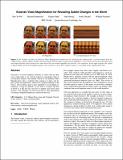| dc.contributor.author | Wu, Hao-Yu | |
| dc.contributor.author | Rubinstein, Michael | |
| dc.contributor.author | Shih, Eugene | |
| dc.contributor.author | Guttag, John V. | |
| dc.contributor.author | Durand, Fredo | |
| dc.contributor.author | Freeman, William T. | |
| dc.date.accessioned | 2014-05-14T19:43:13Z | |
| dc.date.available | 2014-05-14T19:43:13Z | |
| dc.date.issued | 2012-07 | |
| dc.identifier.issn | 07300301 | |
| dc.identifier.uri | http://hdl.handle.net/1721.1/86955 | |
| dc.description.abstract | Our goal is to reveal temporal variations in videos that are difficult or impossible to see with the naked eye and display them in an indicative manner. Our method, which we call Eulerian Video Magnification, takes a standard video sequence as input, and applies spatial decomposition, followed by temporal filtering to the frames. The resulting signal is then amplified to reveal hidden information. Using our method, we are able to visualize the flow of blood as it fills the face and also to amplify and reveal small motions. Our technique can run in real time to show phenomena occurring at the temporal frequencies selected by the user. | en_US |
| dc.description.sponsorship | United States. Defense Advanced Research Projects Agency (DARPA SCENICC program) | en_US |
| dc.description.sponsorship | National Science Foundation (U.S.) (NSF CGV-1111415) | en_US |
| dc.description.sponsorship | Quanta Computer (Firm) | en_US |
| dc.description.sponsorship | Nvidia Corporation (Graduate Fellowship) | en_US |
| dc.language.iso | en_US | |
| dc.publisher | Association for Computing Machinery | en_US |
| dc.relation.isversionof | http://dx.doi.org/10.1145/2185520.2185561 | en_US |
| dc.rights | Creative Commons Attribution-Noncommercial-Share Alike | en_US |
| dc.rights.uri | http://creativecommons.org/licenses/by-nc-sa/4.0/ | en_US |
| dc.source | MIT web domain | en_US |
| dc.title | Eulerian video magnification for revealing subtle changes in the world | en_US |
| dc.type | Article | en_US |
| dc.identifier.citation | Wu, Hao-Yu, Michael Rubinstein, Eugene Shih, John Guttag, Frédo Durand, and William Freeman. “Eulerian Video Magnification for Revealing Subtle Changes in the World.” ACM Transactions on Graphics 31, no. 4 (July 1, 2012): 1–8. | en_US |
| dc.contributor.department | Massachusetts Institute of Technology. Computer Science and Artificial Intelligence Laboratory | en_US |
| dc.contributor.department | Massachusetts Institute of Technology. Department of Electrical Engineering and Computer Science | en_US |
| dc.contributor.mitauthor | Wu, Hao-Yu | en_US |
| dc.contributor.mitauthor | Rubinstein, Michael | en_US |
| dc.contributor.mitauthor | Guttag, John V. | en_US |
| dc.contributor.mitauthor | Durand, Fredo | en_US |
| dc.contributor.mitauthor | Freeman, William T. | en_US |
| dc.relation.journal | ACM Transactions on Graphics | en_US |
| dc.eprint.version | Author's final manuscript | en_US |
| dc.type.uri | http://purl.org/eprint/type/ConferencePaper | en_US |
| eprint.status | http://purl.org/eprint/status/NonPeerReviewed | en_US |
| dspace.orderedauthors | Wu, Hao-Yu; Rubinstein, Michael; Shih, Eugene; Guttag, John; Durand, Frédo; Freeman, William | en_US |
| dc.identifier.orcid | https://orcid.org/0000-0002-3707-3807 | |
| dc.identifier.orcid | https://orcid.org/0000-0003-0992-0906 | |
| dc.identifier.orcid | https://orcid.org/0000-0001-9919-069X | |
| dc.identifier.orcid | https://orcid.org/0000-0002-2231-7995 | |
| mit.license | OPEN_ACCESS_POLICY | en_US |
| mit.metadata.status | Complete | |
